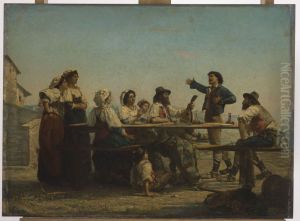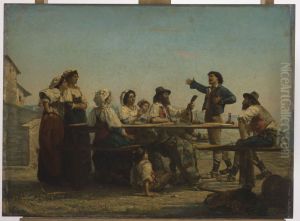Edouard Brandon Paintings
Édouard Brandon was a French artist born in Paris on December 28, 1831. He is best known for his work as a painter, but he was also a skilled engraver. Brandon's artistic talent emerged at an early age, and he pursued his passion for art through formal education. He studied under esteemed French painters such as Émile Signol and Paul Delaroche, both of whom were influential figures at the École des Beaux-Arts in Paris. These teachers played a significant role in shaping Brandon’s classical style, which was typical of many 19th-century French artists.
Brandon’s works were primarily in the academic style, focusing on historical and mythological subjects, as well as portraiture and genre scenes. His paintings were characterized by their meticulous detail, clear composition, and vibrant colors. He was part of the artistic movements that valued traditional techniques and often rejected the emerging impressionist style that was gaining popularity during his lifetime.
Throughout his career, Édouard Brandon exhibited his works at the prestigious Paris Salon, an annual art exhibition held by the French Academy of Fine Arts. His participation in the Salon helped to establish his reputation as a respected artist. Despite his success, Brandon did not gain the same level of fame as some of his contemporaries.
Brandon's contributions to art continued beyond his own creations. He was also dedicated to educating the next generation of artists. He served as a professor of art, imparting his knowledge and skills to students who would carry on the traditions of the classical style.
Édouard Brandon died on August 23, 1897, in Paris. His works remain a testament to the academic art tradition of the 19th century and continue to be studied and appreciated for their craftsmanship and adherence to the artistic standards of his time.


